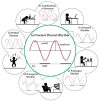Eat, Train, Sleep-Retreat? Hormonal Interactions of Intermittent Fasting, Exercise and Circadian Rhythm
- PMID: 33808424
- PMCID: PMC8065500
- DOI: 10.3390/biom11040516
Eat, Train, Sleep-Retreat? Hormonal Interactions of Intermittent Fasting, Exercise and Circadian Rhythm
Abstract
The circadian rhythmicity of endogenous metabolic and hormonal processes is controlled by a complex system of central and peripheral pacemakers, influenced by exogenous factors like light/dark-cycles, nutrition and exercise timing. There is evidence that alterations in this system may be involved in the pathogenesis of metabolic diseases. It has been shown that disruptions to normal diurnal rhythms lead to drastic changes in circadian processes, as often seen in modern society due to excessive exposure to unnatural light sources. Out of that, research has focused on time-restricted feeding and exercise, as both seem to be able to reset disruptions in circadian pacemakers. Based on these results and personal physical goals, optimal time periods for food intake and exercise have been identified. This review shows that appropriate nutrition and exercise timing are powerful tools to support, rather than not disturb, the circadian rhythm and potentially contribute to the prevention of metabolic diseases. Nevertheless, both lifestyle interventions are unable to address the real issue: the misalignment of our biological with our social time.
Keywords: circadian rhythm; exercise; intermittent fasting; metabolism; stress hormones.
Conflict of interest statement
The authors declare no conflict of interest.
Figures


Similar articles
-
Intermittent fasting contributes to aligned circadian rhythms through interactions with the gut microbiome.Benef Microbes. 2021 Apr 12;12(2):147-161. doi: 10.3920/BM2020.0149. Epub 2021 Feb 3. Benef Microbes. 2021. PMID: 33530881 Review.
-
Circadian regulation of glucose, lipid, and energy metabolism in humans.Metabolism. 2018 Jul;84:11-27. doi: 10.1016/j.metabol.2017.11.017. Epub 2018 Jan 9. Metabolism. 2018. PMID: 29195759 Free PMC article. Review.
-
Controlled light exposure and intermittent fasting as treatment strategies for metabolic syndrome and gut microbiome dysregulation in night shift workers.Physiol Behav. 2023 May 1;263:114103. doi: 10.1016/j.physbeh.2023.114103. Epub 2023 Jan 31. Physiol Behav. 2023. PMID: 36731762 Review.
-
Intermittent feeding and circadian rhythm in critical illness.Curr Opin Crit Care. 2022 Aug 1;28(4):381-388. doi: 10.1097/MCC.0000000000000960. Epub 2022 Jul 5. Curr Opin Crit Care. 2022. PMID: 35797531 Free PMC article. Review.
-
The effect of intermittent fasting during Ramadan on sleep, sleepiness, cognitive function, and circadian rhythm.Sleep Breath. 2017 Sep;21(3):577-586. doi: 10.1007/s11325-017-1473-x. Epub 2017 Feb 11. Sleep Breath. 2017. PMID: 28190167 Review.
Cited by
-
Osteopontin enhances the effect of treadmill training and promotes functional recovery after spinal cord injury.Mol Biomed. 2023 Nov 28;4(1):44. doi: 10.1186/s43556-023-00154-y. Mol Biomed. 2023. PMID: 38015348 Free PMC article.
-
What Is the Relationship between Chronotype and Disordered Eating in Adolescents? The EHDLA Study.Nutrients. 2024 Aug 6;16(16):2576. doi: 10.3390/nu16162576. Nutrients. 2024. PMID: 39203713 Free PMC article.
-
A Narrative Review about Metabolic Pathways, Molecular Mechanisms and Clinical Implications of Intermittent Fasting as Autophagy Promotor.Curr Nutr Rep. 2025 Jun 6;14(1):78. doi: 10.1007/s13668-025-00666-9. Curr Nutr Rep. 2025. PMID: 40481380 Review.
-
Klebsiella pneumoniae alters zebrafish circadian rhythm via inflammatory pathways and is dependent on light cues.Heliyon. 2024 May 7;10(10):e30829. doi: 10.1016/j.heliyon.2024.e30829. eCollection 2024 May 30. Heliyon. 2024. PMID: 38770281 Free PMC article.
-
Changes in sleep, physical activity, and health behaviors among Nigerian fasting adults in Ramadan during the COVID-19 pandemic.J Educ Health Promot. 2024 Aug 29;13:300. doi: 10.4103/jehp.jehp_1579_23. eCollection 2024. J Educ Health Promot. 2024. PMID: 39416987 Free PMC article.
References
Publication types
MeSH terms
Substances
LinkOut - more resources
Full Text Sources
Other Literature Sources
Medical

